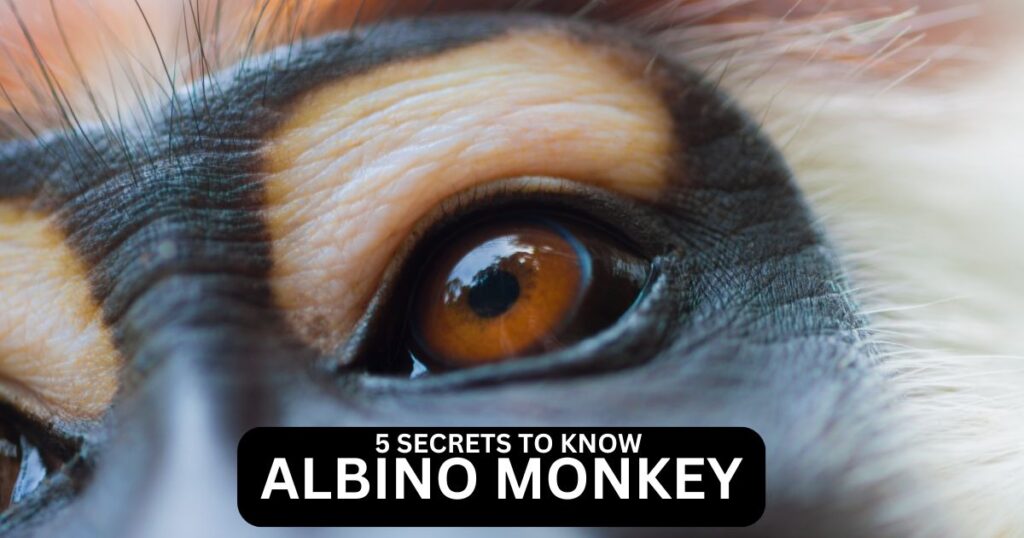5 Secrets About Albino Monkey: White Fur, Red Eyes, More!
Albino monkeys are extraordinary animals that catch people’s eyes because of their unique looks. Albinism is a rare genetic condition where the body doesn’t produce melanin, the pigment that gives color to the skin, hair, and eyes. This absence of color results in a white or pale appearance, making albino monkeys stand out from other monkeys.

In this blog post, we will explore what albinism is, the challenges albino monkey face, and the efforts to protect these rare creatures.
Albino Monkey Appearance and Characteristics
Albino monkeys are remarkable because of their distinct and easily recognizable appearance. One of the most striking features of these monkeys is their pure white fur. This bright white color is due to the lack of pigmentation, which makes albino monkeys stand out among other primates.

Another noticeable feature is their eye color. Unlike most monkeys, albino monkeys often have pink or red eyes. This unusual eye color happens because, without melanin, the tiny blood vessels in their eyes become visible, giving them a pink or red hue.
Additionally, their pink or red eyes often have poor vision, making it harder for them to see clearly, especially in bright sunlight.
Albino monkeys can be found in various sizes, depending on their species. For example, some are as small as the pygmy marmoset, one of the tiniest monkeys in the world. On the other hand, larger albino monkeys can grow up to 3.5 feet long and weigh as much as 80 pounds.
These special features also create challenges that albino monkeys must face throughout their lives.
Species of Albino Monkeys
Although albinism is rare, it can be found in various monkey species. Here are some Species of Albino Monkey examples:
- Albino Capuchin Monkeys: Capuchin monkeys are known for being smart and social. Sometimes, they are born with albinism. They are often found in Central and South America.
- Albino Spider Monkeys: These monkeys have long limbs and are great climbers. Albinism in spider monkeys is rare and can make it harder for them to blend in with their surroundings.
- Albino Orangutans: Orangutans live in the rainforests of Borneo and Sumatra. Although albino orangutans are rare, they have been documented, and their unique appearance always draws attention.
Albino Monkey 5 Amazing Facts
1- Rare Condition:
Albinism is extremely rare among monkeys, making albino monkeys a unique sight in the wild.
2- Sensitive to Sunlight:
Albino monkeys are highly sensitive to sunlight due to the lack of melanin normally protects the skin from UV rays.
3- Vision Problems:
Many albino monkeys suffer from poor eyesight, which can include issues like light sensitivity, blurry vision, and even partial blindness.
4- Shorter Lifespan:
Due to their increased vulnerability to predators, health issues, and social challenges, albino monkeys often have shorter lifespans compared to their non-albino counterparts.
5- Cultural Significance:
In some cultures, albino animals see as sacred or symbolic, while in others, they may be view with suspicion or fear.
What Do Albino Monkeys Eat?
Albino monkeys generally eat the same diet as their non-albino counterparts, depending on their species and habitat. Here’s a general overview of what they consume:

- Fruits: A large portion of a monkey’s diet consists of fruits, which provide essential vitamins and nutrients.
- Leaves and Flowers: Many monkeys eat leaves and flowers as a source of fiber and nutrients. This is especially common in species like howler monkeys.
- Insects: Some monkeys, like capuchins, are omnivorous and include insects in their diet for protein.
- Nuts and Seeds: Monkeys often eat nuts and seeds, which are rich in fats and help them maintain energy.
- Small Animals: In some cases, monkeys may eat small animals, such as lizards or birds, as part of their diet, especially in species that are more omnivorous.
Despite their albinism, these monkeys still rely on their natural instincts to find food, though poor eyesight and lack of camouflage can make this more challenging in the wild.
The Life of Albino Monkeys
Albino monkeys face many challenges in the wild. Their lack of pigmentation makes them more noticeable to predators, which increases their risk of being hunt. Additionally, they often have poor vision, making it harder for them to find food and move around safely in their environment.

Challenges in the Wild
- Predation: The bright white fur of albino monkeys makes them easy targets for predators because they can’t blend in with their surroundings like other monkeys can.
- Social Exclusion: Sometimes, albino monkeys might face social challenges within their groups. Other monkeys may treat them differently because of their unusual appearance, which can lead to exclusion or even bullying.
- Health Issues: Without melanin, albino monkeys are more likely to get sunburn and develop skin cancer. They are also at a higher risk for other health problems related to sun exposure, which can shorten their lifespan.
\Albino Monkeys in Zoos and Sanctuaries
In captivity, albino monkeys can be better protected from predators. Zoos and sanctuaries often provide a controlled environment where they can live more safely. However, these monkeys still need special care because of their unique needs.
Care in Captivities
- Health Monitoring: Caretakers in zoos closely watch albino monkeys for any signs of skin damage or other health issues related to their albinism. Regular veterinary check-ups are essential to keep them healthy.
- Enrichment Activities: To keep albino monkeys mentally and physically active, caretakers provide enrichment activities like puzzles, climbing structures, and interactive toys. These activities help stimulate their natural behaviours and keep them engaged.
- Socialization: Caretakers carefully introduce albino monkeys to other monkeys to make sure they can join social groups without facing bullying or exclusion.
Protecting Albino Monkeys: Conservation Efforts and Strategies
Given the unique challenges albino monkeys face, conservation efforts are vital for their survival. Various organizations work hard to protect these rare animals and their natural habitats.

Key Conservation Initiatives
- Habitat Preservation: Protecting the natural habitats of albino monkeys is crucial. Deforestation and habitat destruction are significant threats to their survival. Conservation groups advocate for preserving rainforests and natural ecosystems where these monkeys live.
- Research and Education: Ongoing research helps us better understand the needs and behaviors of albino monkeys. Educational programs raise awareness about albinism and the challenges these monkeys face, helping people appreciate their uniqueness.
- Rescue and Rehabilitation: Many organizations focus on rescuing and rehabilitating albino monkeys found in the wild or kept in poor conditions in captivity. These efforts ensure that albino monkeys get the care and protection they need.
READ: How Long Can I Receive Social Welfare Benefits
Conclusion
Albino monkeys are remarkable creatures that show the incredible diversity of the animal world. Their unique appearance, caused by a genetic condition, makes them both beautiful and vulnerable.
Understanding their needs and the challenges they face is crucial for their conservation. Through dedicated efforts to protect their habitats and raise awareness, we can help ensure that these extraordinary animals continue to thrive for generations to come.
READ: How Effective Are Social Services in South Africa?
FAQs
Albino monkeys are extremely rare. Albinism is a rare genetic condition, so finding an albino monkey in the wild is uncommon.
Yes, albino monkeys do exist, but they are very rare. They can be find in the wild, though sightings are infrequent, and some are keep in zoos and sanctuaries.
Yes, albino monkeys often have red or pink eyes. This happens because they lack pigment in their eyes, making the blood vessels more visible.
Albino monkeys live in the same habitats as non-albino monkeys of their species. This can include rainforests, savannas, and woodlands, depending on the species.
There is no exact count of how many albino monkeys are leave in the world, but they are very rare, with only a few known to exist.
Albino monkeys generally have a shorter lifespan compared to their non-albino counterparts due to their increased vulnerability to predators and health issues like skin cancer and vision problems.
Adopting an albino monkey as a pet is not recommended or legal in most places. However, some zoos and sanctuaries offer adoption programs where you can sponsor the care of an albino monkey.
Some fun names for albino monkeys could be Snowball, Ghost, Pearl, or Ivory. These names reflect their unique, pale appearance.
Baby albino monkeys are born with the same white or pale fur as adults and may have red or pink eyes. They are smaller and need special care, especially in the wild.
Albino monkeys are extremely rare, and there are only a few known to exist in the world. Exact numbers are not available, but sightings are very uncommon.







